Hammock on:
[Wikipedia]
[Google]
[Amazon]

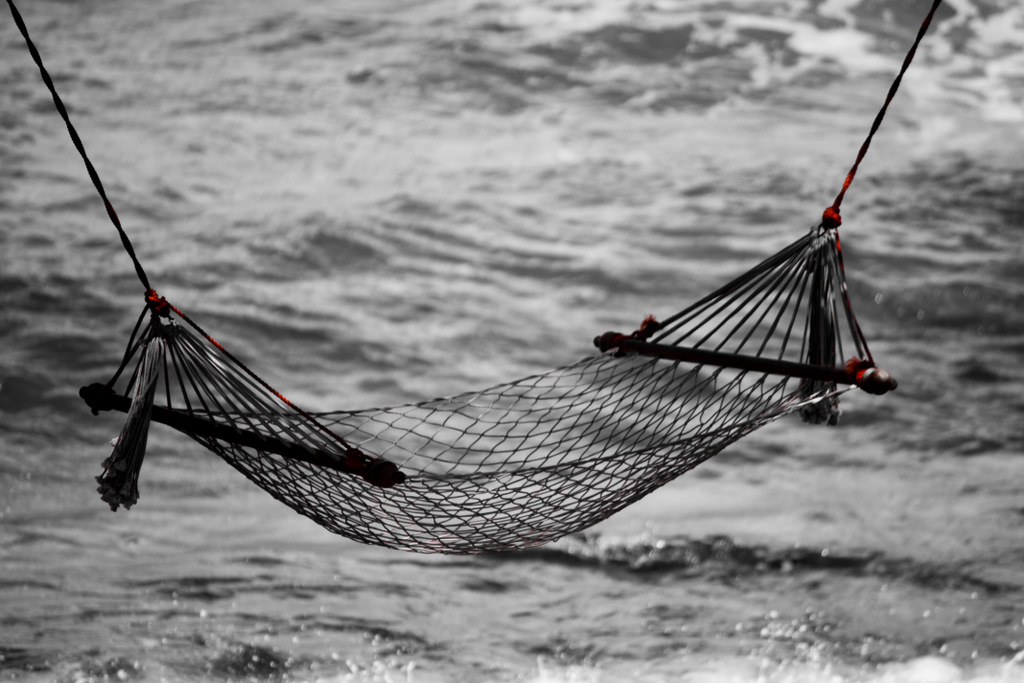 A hammock (from Spanish , borrowed from
A hammock (from Spanish , borrowed from
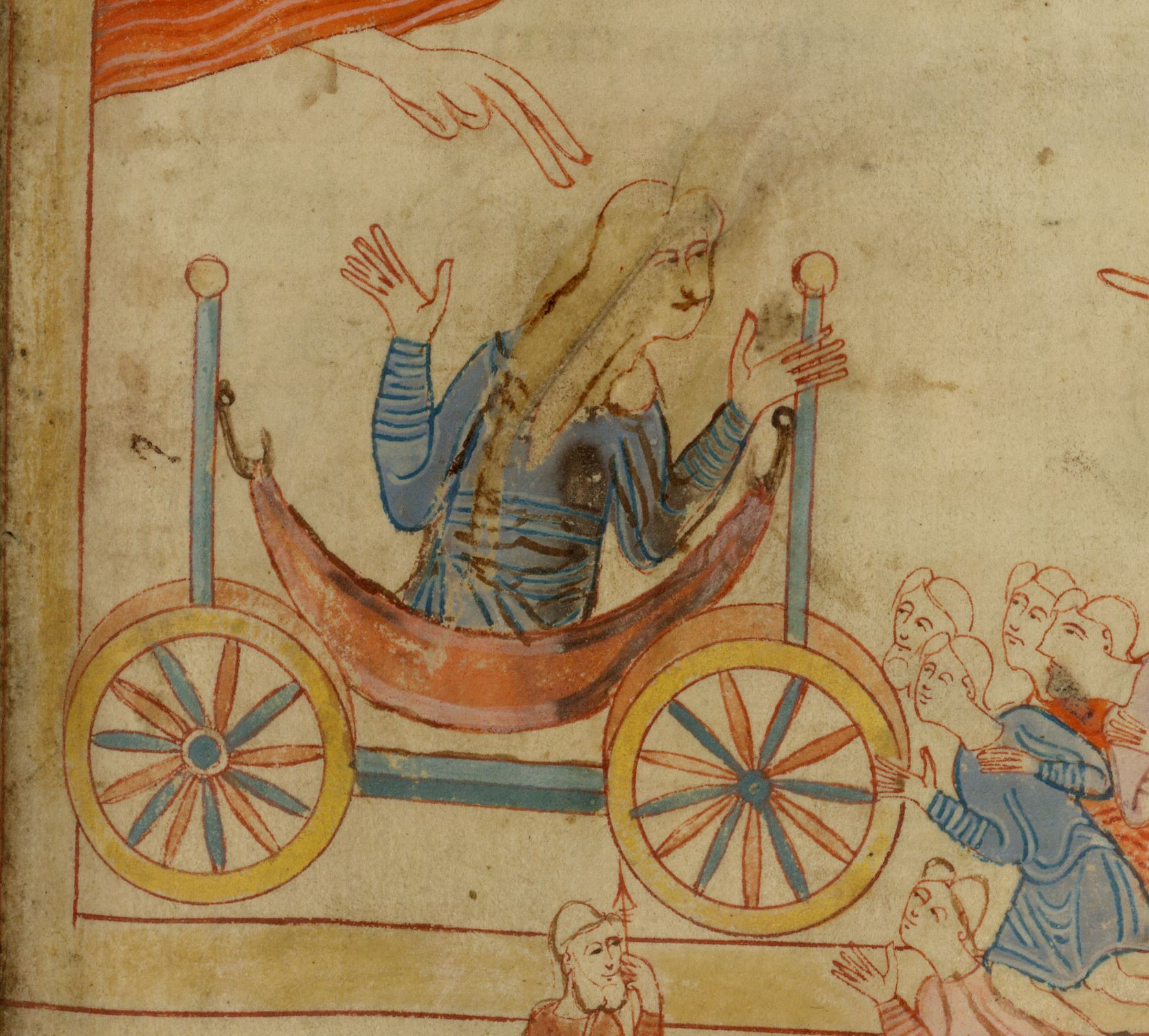
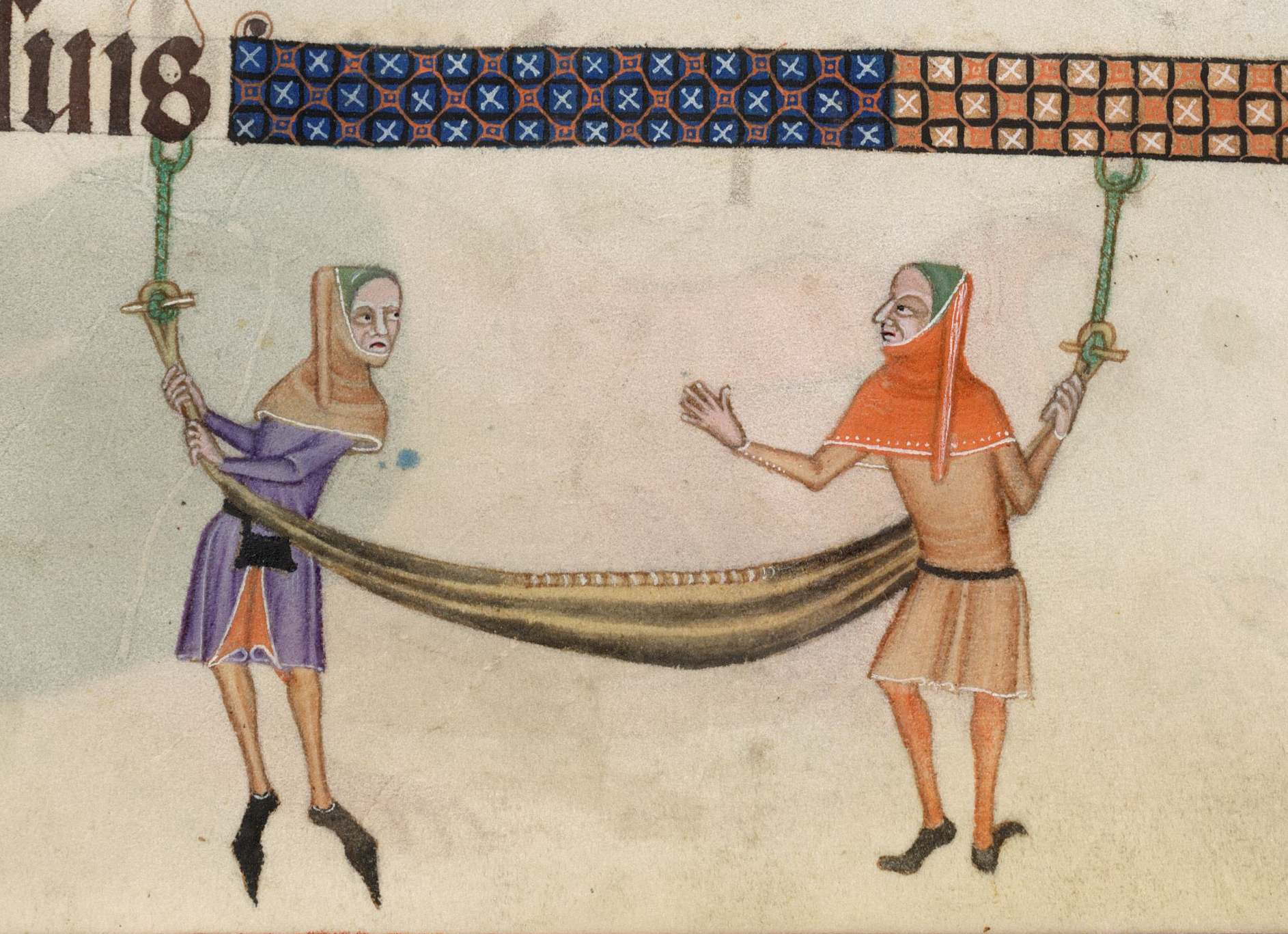 Some 19th-century authors attributed the invention of the hammock to the Athenian politician Alcibiades (d. 404 BC).
Some 19th-century authors attributed the invention of the hammock to the Athenian politician Alcibiades (d. 404 BC).
 Spanish colonists noted the use of the hammock by Native Americans, particularly in the
Spanish colonists noted the use of the hammock by Native Americans, particularly in the 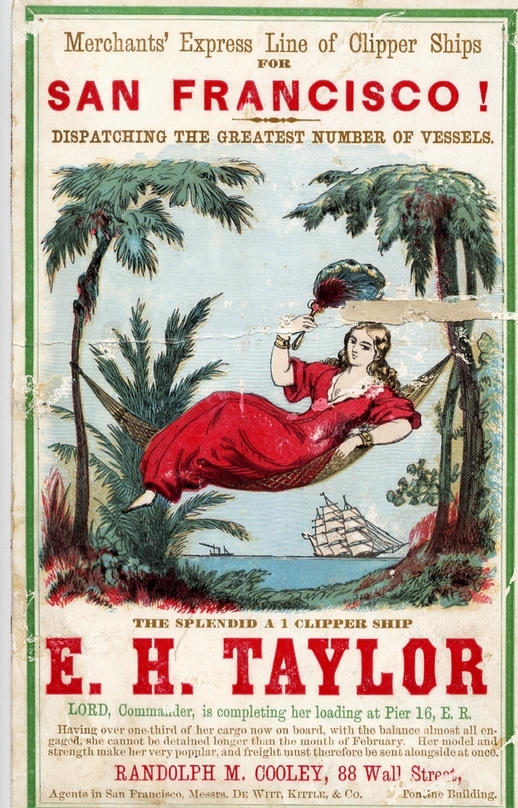 Early hammocks were woven out of tree bark, and later this material was replaced by
Early hammocks were woven out of tree bark, and later this material was replaced by 
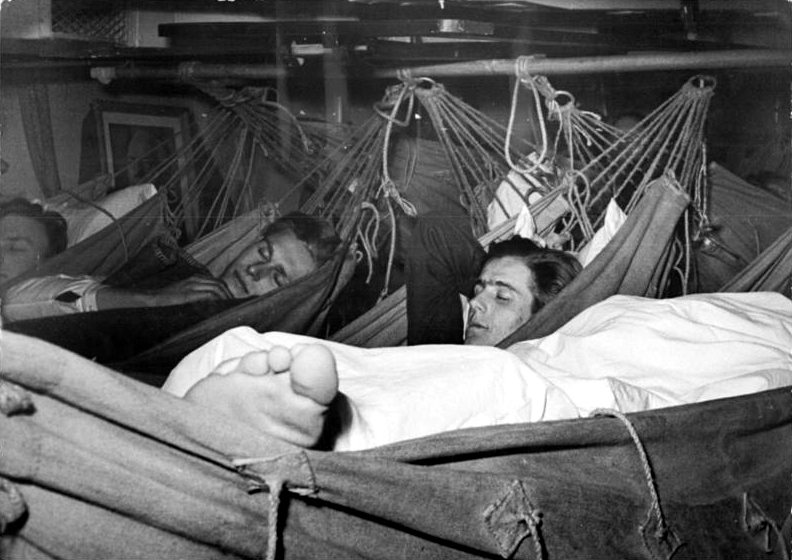
 El Salvador is a large producer and exporter of hammocks . The valley in which San Salvador City sits is dubbed "The Valley of the Hammocks" because the Native Americans used hammocks to "repel" constant earthquakes. Later, the colonizing Spaniards used the term as an allusion to earthquakes constantly rocking the valley like a hammock. Hammocks are a big part of Salvadoran culture and are often used for afternoon naps. It is completely socially acceptable to lie in a hammock all day in this
El Salvador is a large producer and exporter of hammocks . The valley in which San Salvador City sits is dubbed "The Valley of the Hammocks" because the Native Americans used hammocks to "repel" constant earthquakes. Later, the colonizing Spaniards used the term as an allusion to earthquakes constantly rocking the valley like a hammock. Hammocks are a big part of Salvadoran culture and are often used for afternoon naps. It is completely socially acceptable to lie in a hammock all day in this
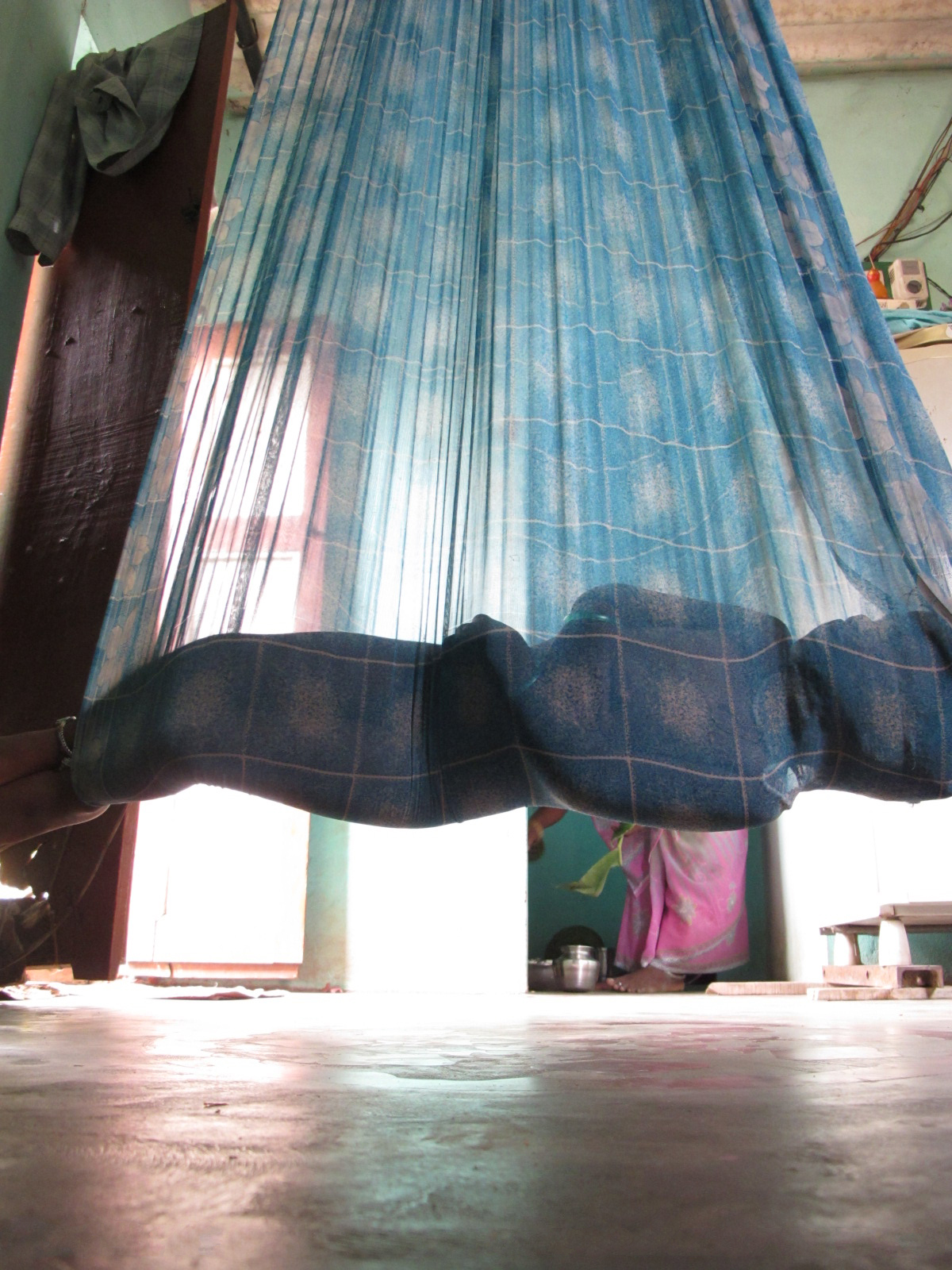 Ceiling mounted hammocks for babies are traditional to south
Ceiling mounted hammocks for babies are traditional to south
 The first two men to walk on the moon,
The first two men to walk on the moon,
File:Bridge_Hammock.jpg, Bridge hammock with bugnet
File:HammockinYard.jpg, Hammock on a frame in a residential backyard
File:Otavalo Artisan Market - Andes Mountains - South America - photograph 064.JPG, Traditional hammocks,
Otavalo Artisan Market,
residential backyard. File:Snowy hammock in Étalle (DSCF6709).jpg, Hammock with tarp and underquilt File:Hammocks brazil.jpg, Hammocks,
Amazon River island,
Brazil.
Hammocks are very popular in the Brazilian northeast region, but not only as sleeping devices: in the poorest areas of the sertão, if there is not a
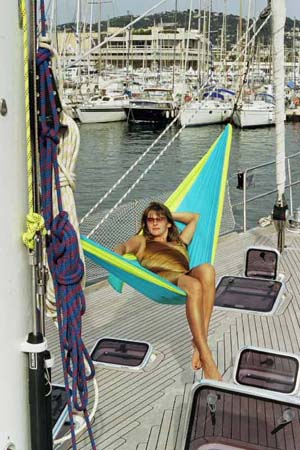 Travel or camping hammocks are popular among leave no trace and ultra-light campers, hikers, and sailing enthusiasts for their reduced impact on the environment and their lightness and lack of bulk compared to tents. They are typically made of sturdy nylon parachute fabric which may use
Travel or camping hammocks are popular among leave no trace and ultra-light campers, hikers, and sailing enthusiasts for their reduced impact on the environment and their lightness and lack of bulk compared to tents. They are typically made of sturdy nylon parachute fabric which may use
File:AKP 0827 temp.jpg, Nylon ripstop
camping hammock File:Grand Turk(38).jpg, Hammock aboard the '' Grand Turk'' File:HammockonBeach.jpg, Hammock on a tropical beach File:Pangkor Hammock.jpg, Baby hammock,
Kuangsi sanctuary, Laos

 A hammock (from Spanish , borrowed from
A hammock (from Spanish , borrowed from Taíno
The Taíno were a historic indigenous people of the Caribbean whose culture has been continued today by Taíno descendant communities and Taíno revivalist communities. At the time of European contact in the late 15th century, they were the pri ...
and Arawak
The Arawak are a group of indigenous peoples of northern South America and of the Caribbean. Specifically, the term "Arawak" has been applied at various times to the Lokono of South America and the Taíno, who historically lived in the Great ...
) is a sling made of fabric, rope, or netting, suspended between two or more points, used for swinging, sleep
Sleep is a sedentary state of mind and body. It is characterized by altered consciousness, relatively inhibited sensory activity, reduced muscle activity and reduced interactions with surroundings. It is distinguished from wakefulness by a de ...
ing, or resting. It normally consists of one or more cloth panels, or a woven network of twine or thin rope stretched with ropes between two firm anchor points such as trees or posts. Hammocks were developed by native inhabitants of the Americas
The Americas, which are sometimes collectively called America, are a landmass comprising the totality of North and South America. The Americas make up most of the land in Earth's Western Hemisphere and comprise the New World.
Along with th ...
for sleeping, as well as the English
English usually refers to:
* English language
* English people
English may also refer to:
Peoples, culture, and language
* ''English'', an adjective for something of, from, or related to England
** English national ide ...
. Later, they were used aboard ships by sailors to enable comfort and maximize available space, by explorers or soldiers travelling in wooded regions and eventually by parents in the early 1920s for containing babies just learning to crawl. Today they are popular around the world for relaxation; they are also used as a lightweight bed
A bed is an item of furniture that is used as a place to sleep, rest, and relax.
Most modern beds consist of a soft, cushioned mattress on a bed frame. The mattress rests either on a solid base, often wood slats, or a sprung base. Many beds ...
on camping
Camping is an outdoor activity involving overnight stays away from home, either without shelter or using basic shelter such as a tent, or a recreational vehicle. Typically, participants leave developed areas to spend time outdoors in more na ...
trips. The hammock is often seen as a symbol of summer, leisure
Leisure has often been defined as a quality of experience or as free time. Free time is time spent away from business, work, job hunting, domestic chores, and education, as well as necessary activities such as eating and sleeping. Leisur ...
, relaxation and simple, easy living.
Etymology
The word ''hammock'' comes, via Spanish, from aTaíno
The Taíno were a historic indigenous people of the Caribbean whose culture has been continued today by Taíno descendant communities and Taíno revivalist communities. At the time of European contact in the late 15th century, they were the pri ...
culture Arawakan word meaning "stretch of cloth" from the Arawak root . The Amerindian
The Indigenous peoples of the Americas are the inhabitants of the Americas before the arrival of the European settlers in the 15th century, and the ethnic groups who now identify themselves with those peoples.
Many Indigenous peoples of the A ...
origin of the word was often obscured in English-language sources from the late 18th century onward. Samuel Johnson claimed that it was of Saxon origin, but his etymology was soon debunked. Hamaka was meaningfully transformed into modern German ''Hängematte'', Swedish ''Hängmatta'' and Dutch ''Hangmat'', and calque
In linguistics, a calque () or loan translation is a word or phrase borrowed from another language by literal word-for-word or root-for-root translation. When used as a verb, "to calque" means to borrow a word or phrase from another language w ...
d from Swedish into Finnish ''riippumatto'' (all literally ''hanging mat'').
History
Europe

 Some 19th-century authors attributed the invention of the hammock to the Athenian politician Alcibiades (d. 404 BC).
Some 19th-century authors attributed the invention of the hammock to the Athenian politician Alcibiades (d. 404 BC).Thomas Dudley Fosbroke
Thomas Dudley Fosbroke (sometime Fosbrooke) FSA (27 May 17701 January 1842) was an English clergyman and antiquary. He was curate of Horsley, Gloucestershire, until 1810 and then of Walford in Herefordshire. He wrote ''British Monachism'' (2 vo ...
(1825), ''Encyclopædia of Antiquities, and Elements of Archaeology, Classical and Medieval'', Vol. 1, London, p. 270 This was inferred from Plutarch
Plutarch (; grc-gre, Πλούταρχος, ''Ploútarchos''; ; – after AD 119) was a Greek Middle Platonist philosopher, historian, biographer, essayist, and priest at the Temple of Apollo in Delphi. He is known primarily for hi ...
, who wrote that Alcibiades had his galley bed hung from ropes, but did not specifically describe it as a net or sling. Other ancient writers mention the use of hanging beds to improve sleep or health without giving details on their mode of suspension.
The 11th-century Old English Hexateuch The Old English Hexateuch is the collaborative project of the late Anglo-Saxon period that translated the six books of the Hexateuch into Old English, presumably under the editorship of Ælfric of Eynsham. It is the first English vernacular transla ...
shows the biblical Joseph
Joseph is a common male given name, derived from the Hebrew Yosef (יוֹסֵף). "Joseph" is used, along with "Josef", mostly in English, French and partially German languages. This spelling is also found as a variant in the languages of the mo ...
, promoted to the "second chariot" of the pharaoh
Pharaoh (, ; Egyptian: '' pr ꜥꜣ''; cop, , Pǝrro; Biblical Hebrew: ''Parʿō'') is the vernacular term often used by modern authors for the kings of ancient Egypt who ruled as monarchs from the First Dynasty (c. 3150 BC) until the ...
(that is second in command), in a simple type of vehicle, the body of which seems to be a cloth hammock. The piece is suspended on two hooks attached to two opposite posts rising from the chassis. The hammock motif is repeated in the manuscript in a series of increasingly abstract miniatures, leaving it open to interpretation whether the artist had in mind a wheeled hammock litter
Litter consists of waste products that have been discarded incorrectly, without consent, at an unsuitable location. Litter can also be used as a verb; to litter means to drop and leave objects, often man-made, such as aluminum cans, paper cups ...
or a rudimentary coach with a flexible suspension.
The hammock reappears in unequivocal form in another medieval English
Middle English (abbreviated to ME) is a form of the English language that was spoken after the Norman conquest of 1066, until the late 15th century. The English language underwent distinct variations and developments following the Old English p ...
source, the Luttrell Psalter
The Luttrell Psalter (British Library, Add MS 42130) is an illuminated psalter commissioned by Sir Geoffrey Luttrell (1276–1345), lord of the manor of Irnham in Lincolnshire, written and illustrated on parchment ''circa'' 1320–1340 in Engla ...
(dated to c. 1330), where it has developed to a regular hanging bed. The sling now ends in two rope beckets that anticipate the rings of the naval hammock. Like the earliest known naval specimen the fabric is canvas, not the netting the Spanish later encountered in the New World
The term ''New World'' is often used to mean the majority of Earth's Western Hemisphere, specifically the Americas."America." ''The Oxford Companion to the English Language'' (). McArthur, Tom, ed., 1992. New York: Oxford University Press, p. ...
. The Dutch historian of technology André Sleeswyk argues that it may have been this English type that eventually spread through the European navies despite the word ''hammock'' later being adopted from the Americas:
New World
West Indies
The West Indies is a subregion of North America, surrounded by the North Atlantic Ocean and the Caribbean Sea that includes 13 independent island countries and 18 dependencies and other territories in three major archipelagos: the Greate ...
, at the time of the Spanish conquest.
Columbus, in the narrative of his first voyage, says: “A great many Indians in canoes came to the ship to-day for the purpose of bartering their cotton, and hamacas, or nets, in which they sleep.” He observed the widespread use of hammocks during his travels among the Taino people in the Bahamas.
 Early hammocks were woven out of tree bark, and later this material was replaced by
Early hammocks were woven out of tree bark, and later this material was replaced by sisal
Sisal (, ) (''Agave sisalana'') is a species of flowering plant native to southern Mexico, but widely cultivated and naturalized in many other countries. It yields a stiff fibre used in making rope and various other products. The term sisal may ...
fibers because it was more abundant. One of the reasons that hammocks became popular in Central and South America was their ability to provide safety from disease transmission, insect stings, or animal bites. By suspending their beds above ground, inhabitants were better protected from snakes, biting ants, and other harmful creatures.


Naval
Around 1590, hammocks were adopted for use in sailing ships; theRoyal Navy
The Royal Navy (RN) is the United Kingdom's naval warfare force. Although warships were used by English and Scottish kings from the early medieval period, the first major maritime engagements were fought in the Hundred Years' War against ...
formally adopted the sling hammock in 1597 when it ordered three hundred bolts of canvas for "hanging cabbons or beddes". Aboard ship, hammocks were regularly employed for sailors sleeping on the gun decks of warships, where limited space prevented the installation of permanent bunks. Since a slung hammock moves in concert with the motion of the vessel, the occupant is not at a risk of being thrown onto the deck (which may be 5 or 6 feet below) during swells or rough seas. Likewise, a hammock provides more comfortable sleep than a bunk or a berth while at sea since the sleeper always stays well balance
Balance or balancing may refer to:
Common meanings
* Balance (ability) in biomechanics
* Balance (accounting)
* Balance or weighing scale
* Balance as in equality or equilibrium
Arts and entertainment Film
* ''Balance'' (1983 film), a Bulgaria ...
d, irrespective of the motion of the vessel. Prior to the adoption of naval hammocks, sailors would often be injured or even killed as they fell off their berths or rolled on the decks on heavy seas. The sides of traditional canvas naval hammocks wrap around the sleeper like a cocoon, making an inadvertent fall virtually impossible. If suitably packed, they could also be used as emergency flotation devices.
Many sailors in the Royal Navy, during the 1590s at least, used a spreader – a length of wood with a V cut in each end to engage the second hammock string on each side. The first string was set up more tightly than the others so that it raised a protective lip along each side to keep out drafts and prevent the sleeper being thrown out. A narrow mattress was also issued which protected the user from cold from below. In addition naval hammocks could be rolled tightly and stowed in an out of the way place or in nets along the gunwale
The gunwale () is the top edge of the hull of a ship or boat.
Originally the structure was the "gun wale" on a sailing warship, a horizontal reinforcing band added at and above the level of a gun deck to offset the stresses created by firin ...
as additional protection during battle (as was the case during the age of sail). Many sailors became so accustomed to this way of sleeping that they brought their hammocks ashore with them on leave. The naval use of hammocks continued into the 20th century. During World War II
World War II or the Second World War, often abbreviated as WWII or WW2, was a world war that lasted from 1939 to 1945. It involved the vast majority of the world's countries—including all of the great powers—forming two opposing ...
, troopships sometimes employed hammocks for both naval ratings and soldiers in order to increase available space and troop carrying capacity. Many leisure sailors even today prefer hammocks over bunks because of better comfort in sleep while on the high seas.
Hammocks have also been employed on spacecraft in order to utilize available space when not sleeping or resting. During the Apollo program, from Apollo 12 onwards, the Lunar Module was equipped with hammocks for the commander and lunar module pilot to sleep in between moonwalks.
Mexican and Mayan
InMexico
Mexico (Spanish: México), officially the United Mexican States, is a country in the southern portion of North America. It is bordered to the north by the United States; to the south and west by the Pacific Ocean; to the southeast by Guatema ...
, hammocks are made in villages surrounding the capital city of the Yucatán, Mérida, and are sold throughout the world as well as locally. They were not part of Classic era Maya civilization
The Maya civilization () of the Mesoamerican people is known by its ancient temples and glyphs. Its Maya script is the most sophisticated and highly developed writing system in the pre-Columbian Americas. It is also noted for its art, a ...
; they were said to have arrived in the Yucatán from the Caribbean fewer than two centuries before the Spanish conquest
The Spanish Empire ( es, link=no, Imperio español), also known as the Hispanic Monarchy ( es, link=no, Monarquía Hispánica) or the Catholic Monarchy ( es, link=no, Monarquía Católica) was a colonial empire governed by Spain and its predece ...
. In addition to bark and sisal
Sisal (, ) (''Agave sisalana'') is a species of flowering plant native to southern Mexico, but widely cultivated and naturalized in many other countries. It yields a stiff fibre used in making rope and various other products. The term sisal may ...
, hammocks were constructed from various materials, including palm
Palm most commonly refers to:
* Palm of the hand, the central region of the front of the hand
* Palm plants, of family Arecaceae
**List of Arecaceae genera
* Several other plants known as "palm"
Palm or Palms may also refer to:
Music
* Palm (ba ...
fronds. Quality of native and modern hammocks depends greatly on the quality of the material, thread, and the number of threads used. Mayan hammocks are made on a loom and are hand woven by men, women and children. Hammocks are so symbolically and culturally important for the Yucatecans that even the most humble of homes have hammock hooks in the walls.
El Salvador
 El Salvador is a large producer and exporter of hammocks . The valley in which San Salvador City sits is dubbed "The Valley of the Hammocks" because the Native Americans used hammocks to "repel" constant earthquakes. Later, the colonizing Spaniards used the term as an allusion to earthquakes constantly rocking the valley like a hammock. Hammocks are a big part of Salvadoran culture and are often used for afternoon naps. It is completely socially acceptable to lie in a hammock all day in this
El Salvador is a large producer and exporter of hammocks . The valley in which San Salvador City sits is dubbed "The Valley of the Hammocks" because the Native Americans used hammocks to "repel" constant earthquakes. Later, the colonizing Spaniards used the term as an allusion to earthquakes constantly rocking the valley like a hammock. Hammocks are a big part of Salvadoran culture and are often used for afternoon naps. It is completely socially acceptable to lie in a hammock all day in this Central American
Central America ( es, América Central or ) is a subregion of the Americas. Its boundaries are defined as bordering the United States to the north, Colombia to the south, the Caribbean Sea to the east, and the Pacific Ocean to the west. Cen ...
country. Hammocks swing from doorways, inside living rooms, on porches, in outdoor courtyards, and from trees, in all social classes of Salvadoran homes from the most humble rural home to the most prestigious city hotel chains. In rural El Salvador, a family home may have multiple hammocks strung across the main room, for use as seating, as beds, or as sleep-swings for infants. The municipality of " Concepcion Quezaltepeque" celebrates its traditional Hammocks Festival, where artisans produce and sell hammocks, every year between the first and second weekend of November.
Venezuelan
In Venezuela entire villages raised their families in hammocks. During the first part of the 20th century, many scientists, adventurers, geologists and other non-native visitors to Central and South American jungles soon adopted the Venezuelan hammock design, which gave protection against scorpions and venomous snakes such as the '' fer de lance''. The difficult jungle environments of South America encountered by Western explorers soon stimulated further development of the Venezuelan hammock for use in other tropical environments. The Venezuelan hammock's panels were always made of breathable material, necessary to prevent the onset of fungal infections caused by constant rain and high humidity.Kearny, Cresson H. (Major), ''Jungle Snafus...And Remedies'', Oregon Institute (1996), pp. 240–248 Fine-woven sandfly netting was eventually added to provide more complete protection from mosquitoes, flies, and crawling insects, especially in regions notorious formalaria
Malaria is a mosquito-borne infectious disease that affects humans and other animals. Malaria causes symptoms that typically include fever, tiredness, vomiting, and headaches. In severe cases, it can cause jaundice, seizures, coma, or death. S ...
or screwworm infestations. A waterproof top sheet or rainfly could be added to protect the occupant from drenching by heavy nighttime rains, along with ''drip strings'' – short pieces of string tied to suspension lines — to prevent rainwater running from the tree trunk down the hammock cords to the hammock itself. A breathable false cotton (later nylon
Nylon is a generic designation for a family of synthetic polymers composed of polyamides ( repeating units linked by amide links).The polyamides may be aliphatic or semi-aromatic.
Nylon is a silk-like thermoplastic, generally made from pe ...
) bottom panel was frequently added to these jungle hammocks, allowing air to pass through while still preventing mosquito stings to the occupant.
Jungle hammock
The Venezuelan hammock, as modified, eventually became known as a jungle hammock. Simply by wetting the hammock suspension ropes with insecticides orinsect repellent
An insect repellent (also commonly called "bug spray") is a substance applied to skin, clothing, or other surfaces to discourage insects (and arthropods in general) from landing or climbing on that surface. Insect repellents help prevent and cont ...
, the jungle hammock even gave protection against crawling insects with mandibles
In anatomy, the mandible, lower jaw or jawbone is the largest, strongest and lowest bone in the human facial skeleton. It forms the lower jaw and holds the lower teeth in place. The mandible sits beneath the maxilla. It is the only movable bone ...
that could bite holes through the insect netting.
The United States Army
The United States Army (USA) is the land warfare, land military branch, service branch of the United States Armed Forces. It is one of the eight Uniformed services of the United States, U.S. uniformed services, and is designated as the Army o ...
eventually adopted their own version of the jungle hammock, complete with rain proof fly and sandfly netting for use by U.S. and Allied forces in tropical jungle regions such as Burma
Myanmar, ; UK pronunciations: US pronunciations incl. . Note: Wikipedia's IPA conventions require indicating /r/ even in British English although only some British English speakers pronounce r at the end of syllables. As John Wells explai ...
during World War II
World War II or the Second World War, often abbreviated as WWII or WW2, was a world war that lasted from 1939 to 1945. It involved the vast majority of the world's countries—including all of the great powers—forming two opposing ...
. While at first reluctant to accept the idea of its men sleeping in hammocks, the United States Marine Corps
The United States Marine Corps (USMC), also referred to as the United States Marines, is the maritime land force service branch of the United States Armed Forces responsible for conducting expeditionary and amphibious operations through combi ...
later employed jungle hammocks in New Britain and later Pacific island campaigns where heavy rain and insects were prevalent; concerns over injuries from machine gun
A machine gun is a fully automatic, rifled autoloading firearm designed for sustained direct fire with rifle cartridges. Other automatic firearms such as automatic shotguns and automatic rifles (including assault rifles and battle rifles) ar ...
and artillery
Artillery is a class of heavy military ranged weapons that launch munitions far beyond the range and power of infantry firearms. Early artillery development focused on the ability to breach defensive walls and fortifications during siege ...
fire were overcome by first digging a slit trench, then staking the hammock's support lines to suspend the hammock beneath ground level.
Later U.S. Army hammocks issued during the Vietnam War
The Vietnam War (also known by other names) was a conflict in Vietnam, Laos, and Cambodia from 1 November 1955 to the fall of Saigon on 30 April 1975. It was the second of the Indochina Wars and was officially fought between North Vietnam a ...
, such as the M1966 Jungle Hammock, were mistakenly fitted with waterproof bottom panels, which often became filled with water overnight. On the other side, North Vietnamese Army
The People's Army of Vietnam (PAVN; vi, Quân đội nhân dân Việt Nam, QĐNDVN), also recognized as the Vietnam People's Army (VPA) or the Vietnamese Army (), is the military force of the Socialist Republic of Vietnam and the armed win ...
(NVA) and Viet Cong
,
, war = the Vietnam War
, image = FNL Flag.svg
, caption = The flag of the Viet Cong, adopted in 1960, is a variation on the flag of North Vietnam. Sometimes the lower stripe was green.
, active ...
(VC) forces regularly employed jungle hammocks fabricated from scavenged or captured US parachute cloth and shroud lines. Hung well off jungle trails, the hammocks kept down the incidence of disease and illness, which NVA commanders generally regarded as a greater threat than shrapnel
Shrapnel may refer to:
Military
* Shrapnel shell, explosive artillery munitions, generally for anti-personnel use
* Shrapnel (fragment), a hard loose material
Popular culture
* ''Shrapnel'' (Radical Comics)
* ''Shrapnel'', a game by Adam C ...
injuries caused by sleeping above ground.
After the Vietnam War
The Vietnam War (also known by other names) was a conflict in Vietnam, Laos, and Cambodia from 1 November 1955 to the fall of Saigon on 30 April 1975. It was the second of the Indochina Wars and was officially fought between North Vietnam a ...
, the use of hammocks has become popular in Vietnam among the civilians, as the civilians learned how to make hammocks and sleep in them from the American soldiers. Many used parachutes were recycled into hammocks, and also local styles have emerged.https://bitraexport.com.vn/tin-tuc/the-popularity-of-using-hammocks-nowadays-in-vietnam-in-the-past.html
Indian
 Ceiling mounted hammocks for babies are traditional to south
Ceiling mounted hammocks for babies are traditional to south India
India, officially the Republic of India (Hindi: ), is a country in South Asia. It is the seventh-largest country by area, the second-most populous country, and the most populous democracy in the world. Bounded by the Indian Ocean on the so ...
. The textile used is the woven 5 meter Sari
A sari (sometimes also saree or shari)The name of the garment in various regional languages include:
* as, শাৰী, xārī, translit-std=ISO
* bn, শাড়ি, śāṛi, translit-std=ISO
* gu, સાડી, sāḍī, translit-std ...
, which is long enough to be hung high, yet reach low enough to be safe for toddlers. The light material allows perspiration and cooling in the hot climate native to this region.
Lunar crewed missions
 The first two men to walk on the moon,
The first two men to walk on the moon, Apollo 11
Apollo 11 (July 16–24, 1969) was the American spaceflight that first landed humans on the Moon. Commander Neil Armstrong and lunar module pilot Buzz Aldrin landed the Apollo Lunar Module ''Eagle'' on July 20, 1969, at 20:17 UTC, ...
astronauts Neil Armstrong and Buzz Aldrin
Buzz Aldrin (; born Edwin Eugene Aldrin Jr.; January 20, 1930) is an American former astronaut, engineer and fighter pilot. He made three spacewalks as pilot of the 1966 Gemini 12 mission. As the Lunar Module ''Eagle'' pilot on the 1969 A ...
, spent their rest periods on the Apollo
Apollo, grc, Ἀπόλλωνος, Apóllōnos, label=genitive , ; , grc-dor, Ἀπέλλων, Apéllōn, ; grc, Ἀπείλων, Apeílōn, label= Arcadocypriot Greek, ; grc-aeo, Ἄπλουν, Áploun, la, Apollō, la, Apollinis, label ...
lunar module floor and reported being too cold to sleep comfortably.
From the mission Apollo 12 until the last Apollo lunar mission, hammocks designed to attach to the interior of the lunar module ascent stage were provided. They helped reduce the cooling effects of contact with the cabin floor as well as a softer support. They enabled astronauts from the last missions to spend complete nights of sleep on the moon.
Current
Usage
There are currently a wide variety of hammocks available. There are hammocks that are designed specifically forbackpacking
Backpacking may refer to:
* Backpacking (travel), low-cost, independent, international travel
* Backpacking (hiking), trekking and camping overnight in the wilderness
* Ultralight backpacking, a style of wilderness backpacking with an emphasis on ...
and include mosquito
Mosquitoes (or mosquitos) are members of a group of almost 3,600 species of small flies within the family Culicidae (from the Latin ''culex'' meaning " gnat"). The word "mosquito" (formed by ''mosca'' and diminutive ''-ito'') is Spanish for "li ...
netting along with pockets for nighttime storage. There are hammocks made out of thin and lightweight material which makes them ideal for taking on daytrips. Other hammocks include self-standing metal
A metal (from Greek μέταλλον ''métallon'', "mine, quarry, metal") is a material that, when freshly prepared, polished, or fractured, shows a lustrous appearance, and conducts electricity and heat relatively well. Metals are typicall ...
or wood
Wood is a porous and fibrous structural tissue found in the stems and roots of trees and other woody plants. It is an organic materiala natural composite of cellulose fibers that are strong in tension and embedded in a matrix of lignin ...
structures that support the hammock. Given that hammocks are commonly similar lengths to accommodate for an average adult's height, most hammock stands are universal in design, typically featuring a spreader bar that runs along the ground, feet for stability at each end, and a diagonal arm at each end to provide two hanging points. Although they are usually bought premade, it is also possible to make your own hammock.
Otavalo Artisan Market,
Andes
The Andes, Andes Mountains or Andean Mountains (; ) are the longest continental mountain range in the world, forming a continuous highland along the western edge of South America. The range is long, wide (widest between 18°S – 20°S ...
Mountains, Ecuador
Ecuador ( ; ; Quechua: ''Ikwayur''; Shuar: ''Ecuador'' or ''Ekuatur''), officially the Republic of Ecuador ( es, República del Ecuador, which literally translates as "Republic of the Equator"; Quechua: ''Ikwadur Ripuwlika''; Shuar: ' ...
.
File:CrochetHammock.jpg, Crocheted hammock
File:Hammockingarden.jpg, Nylon hammock,residential backyard. File:Snowy hammock in Étalle (DSCF6709).jpg, Hammock with tarp and underquilt File:Hammocks brazil.jpg, Hammocks,
Amazon River island,
Brazil.
cemetery
A cemetery, burial ground, gravesite or graveyard is a place where the remains of dead people are buried or otherwise interred. The word ''cemetery'' (from Greek , "sleeping place") implies that the land is specifically designated as a buri ...
in a settlement, hammocks may be used to carry the dead to a locale where there is one; also, they frequently serve as a low-cost alternative to coffins. This custom inspired Candido Portinari
Candido Portinari (December 29, 1903 – February 6, 1962) was a Brazilian painter. He is considered one of the most important Brazilian painters as well as a prominent and influential practitioner of the neo-realism style in painting.
Portinari ...
's 1944 painting ''Enterro na Rede'' ("burial in the hammock"). Traditionally the sailor
A sailor, seaman, mariner, or seafarer is a person who works aboard a watercraft as part of its crew, and may work in any one of a number of different fields that are related to the operation and maintenance of a ship.
The profession of the s ...
s who have died at sea were buried at sea
Burial at sea is the disposal of human remains in the ocean, normally from a ship or boat. It is regularly performed by navies, and is done by private citizens in many countries.
Burial-at-sea services are conducted at many different location ...
in their hammocks.
Medical research suggests the gentle rocking motion of the hammock allows users to fall asleep faster and sleep more deeply compared to a traditional, stationary mattress.
Styles
Current popular hammock styles include the spreader-bar, Mayan, Brazilian, naval, Nicaraguan, Venezuelan (jungle), and travel hammocks. Each style is distinctive and has its own set of advantages and disadvantages. Many hammocks come in a variety of colors, patterns, and sizes ranging from a one-person (250 – 350 lbs / 110 – 160 kg) to two or three person (400 lbs – 600 lbs / 180 – 270 kg). Common dimensions for unslung hammocks fall in a range between 3'/0.9m to 14'/4.2m across and 6'/1.8m to 11'/3.3m long. The spreader-bar hammock is easily recognized by wooden or metal bars at the head and foot of the hammock, spreading its width and allowing for easy access for casual use, such as in a backyard. Unfortunately, the spreader bars also make the hammock unsteady since the metacenter of the hammock when sleeping is very high. This style is generally considered less stable and less comfortable for sleeping than other styles. A subset of this style is the single-spreader bar hammock, which uses a spreader bar on only one end and is much more stable. A variation of the single-spreader bar hammock has three attachment points, one at each corner of the spreader bar and one at the non-spreader bar end, and is nearly untippable. While the various styles of hammocks available today are similar in form, they differ significantly in materials, purpose, and construction. Mayan and Nicaraguan hammocks are made from eithercotton
Cotton is a soft, fluffy staple fiber that grows in a boll, or protective case, around the seeds of the cotton plants of the genus '' Gossypium'' in the mallow family Malvaceae. The fiber is almost pure cellulose, and can contain minor pe ...
or nylon string that is woven to form a supportive net. Mayan Hammocks have a looser weave than Nicaraguan hammocks, and the supportiveness of the hammock "bed" depends on the number of strings and quality of the weave.
Brazilian hammocks are made from cotton fabric and usually more durable than the string varieties. While Mayan and Nicaraguan hammocks are considered by some to have the potential to be more comfortable, the Brazilian hammock's comfort is less dependent on its construction and therefore less likely to vary as highly from manufacturer to manufacturer.
Naval hammocks are usually made from canvas or strong cotton. They are intended to be durable and stand well the hardships of shipboard use. They usually are simple and undecorated but robust.
Venezuelan or jungle hammocks made today are generally of breathable nylon or polyester, and use dacron or similar non-stretch suspension lines. They are "inline" hammocks; like the canvas naval hammocks of old, the occupant sleeps along the length of the hammock, rather than across it. With their breathable false bottoms, drip strings, sandfly netting, and optional rainfly, they are one of the most secure hammocks against not only water entry, but also insect stings or bites.
 Travel or camping hammocks are popular among leave no trace and ultra-light campers, hikers, and sailing enthusiasts for their reduced impact on the environment and their lightness and lack of bulk compared to tents. They are typically made of sturdy nylon parachute fabric which may use
Travel or camping hammocks are popular among leave no trace and ultra-light campers, hikers, and sailing enthusiasts for their reduced impact on the environment and their lightness and lack of bulk compared to tents. They are typically made of sturdy nylon parachute fabric which may use ripstop
__NOTOC__
Ripstop fabrics are woven fabrics, often made of nylon, using a reinforcing technique that makes them more resistant to tearing and ripping. During weaving, stronger (and often thicker) reinforcement yarns are interwoven at regular inte ...
techniques to improve durability. Some hammocks feature a mosquito net and storage pockets. Some types offer a ridgeline to make set up easier, and may also include a slit for entry through the bottom of the hammock. Special webbing straps (called "treehuggers") are used to loop around trees in order to create attachment points for the hammock.
Set-up and use
For non spreader-bar styles, the way in which they are hung is critical for comfort. Generally, a higher attachment point is preferred as well as sufficient length between points, though these two dimensions can be adjusted to compensate for a lack in one or the other. The optimal angle of the attaching lines to the post / wall / tree is usually about 30 degrees.Derek Hansen: The ultimate hang, page 14, Hammocks can be attached to the anchor points using a variety of suspension systems, including ropes and webbing straps.Derek Hansen: The ultimate hang, page 291, Though one can lie in a hammock lengthwise or across its width, most hammocks are best used with a diagonal position, as it provides the most room and support. Users with back and joint pains often report some relief from these problems when sleeping in a hammock in this manner.Gallery
camping hammock File:Grand Turk(38).jpg, Hammock aboard the '' Grand Turk'' File:HammockonBeach.jpg, Hammock on a tropical beach File:Pangkor Hammock.jpg, Baby hammock,
Pangkor
Pangkor Island ( ms, Pulau Pangkor) is an island in Manjung District, Perak, Malaysia. It has a population of approximately 25,000. Nearby islands include Pangkor Laut Island, Giam Island, Mentagor Island, Simpan Island, and Tukun Terindak Islan ...
File:Bear in Hammock.JPG, Bear in a hammockKuangsi sanctuary, Laos
See also
*Cresson Kearny Cresson Henry Kearny (; – ) wrote several survival-related books based primarily on research performed at Oak Ridge National Laboratory.
Career
Kearny attended Texas Military Institute in the 1930s, where he became the commanding officer of th ...
* Hammock camping
* Swing (seat)
A swing is a seat, often found at playgrounds for children, at a circus for acrobats, or on a porch for relaxing, although they may also be items of indoor furniture, such as the Latin American hammock or the Indian oonjal. The seat of a swing ...
* Mothership Space Net Penthouse
References
Sources
* * * {{Authority control Beds Camping equipment Watercraft components